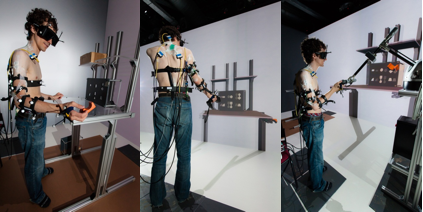VR-GO – Ergonomics in virtual environment

Proposer : Madeleine Pascal, Alboorg University, Denmark
Visited laboratory: INRIA, Rennes, France
Visit Dates : 24 June- 7 July 2012
The objectives of the VR-GO – Ergonomics in virtual environment project are to perform manual handling tasks in both real environment (RE) and virtual environment (VE). More specifically, the effects of VE, without or with force feedback, compared with RE are analyzed in terms of changes in the movement pattern and muscle coordination by means of kinetic, kinematics and multi-channel surface electromyography (EMG) recordings.
The teams included Afshin Samani and Pascal Madeleine, who are with Center for Sensory-Motor Interaction (SMI), Aalborg University, Denmark. Charles Pontonnier, Marwan Badawi, and Georges Dumont are with IRISA/INRIA/ENS Cachan, Campus Universitaire de Beaulieu, Rennes, France.
The research involved sixteen healthy subjects without known neuromuscular disorders or pain, and without previous experience in VR. Their task consisted of grabbing wooden objects from a shelf and passing it through a work panel if it fits, otherwise they have to set it aside on a disposal shelf. Volunteers repeated the task 12 times with six fitting (fitter) objects and six non-fitting (non-fitter) objects. The task was performed at two timing regimes: as fast as possible and time managed.
Recordings & Results: All the recordings were performed using Immersia facilities, which include a high-resolution stereoscopic immersion room with a wall and a floor, 3D glasses tracked with a 360° tracking system and 16 ART infrared cameras (IRISA Rennes, France) and EMG amplifiers (Aalborg University, Denmark).
In Pontonnier et al. (2012), motion of the upper body and five muscle EMG activities all along the kinematical chain were recorded to compute normalized and averaged objective indicators, i.e., rapid upper limb assessment (RULA) score, averaged muscle activations (AMA) and total task time (TTT). Rate of perceived exertion (RPE), using the CR-10 Borg’s scale, and a questionnaire were used as subjective indices.
We found significant differences between measured indicators in RE and VE. RULA score and AMAs tended to decrease in VE under the same task conditions, whereas TTT and RPE tended to increase. This indicates that even if VE resulted in more comfortable postures, subjects experienced more discomfort and more fatigue in VE than in RE, in accordance with the questionnaire results. Fairly good correlation levels were found between VE and RE for six of the objective indicators, i.e. RULA score, Erector Spinae AMA, Deltoideus Medialis AMA, Biceps Brachii, Triceps Long Head AMA and Flexor Carpi Ulnaris AMA.
In Samani et al (2012), high density EMG was recorded over trapezius and split into its cycles. The linear envelop of EMG was computed across cycle and resampled in time to get 20 samples representing a cycle in five percent intervals. The EMG was ordered in a 13×4 grid to map its spatial configuration. The disparity, similarity and center of spatial distribution of EMG maps were compared for the three platforms in terms of normalized mutual information and center of the gravity of the maps. The virtual platform indicated a fair similarity and comparable disparity with the real platform, but depending on the timing regime and object type (fitter/non-fitter), the force feedback platform differed from the real one.
Conclusions: Using VR for ergonomics purposes needs to be done with caution, as interaction and simulation choices deeply affect cognition and motor control. Such assessment can be done if the offset between VE and RE is defined and taken into account. The use of force feedback in VE was especially challenging. Finally, designing a VE simulator relies on a compromise between functional and subjective fidelity, as subjective experience may be counter-productive in terms of functionality.
Publications (in process):
Pontonnier et al. (2012). Subjective and Functional Realism. Assessing the Propensity of VR Simulators to Properly Evaluate Physical Risk Factors. Submitted to IEEE Virtual Reality 2013 (16-20 March 2013, Orlando, Florida, USA)
Samani et al. (2012). Assessing the Spatial Pattern of Muscular Activity in Simulated Assembly Tasks Comparing Real and Virtual Environment. Submitted to IEEE Virtual Reality 2013 (16-20 March 2013, Orlando, Florida, USA)
